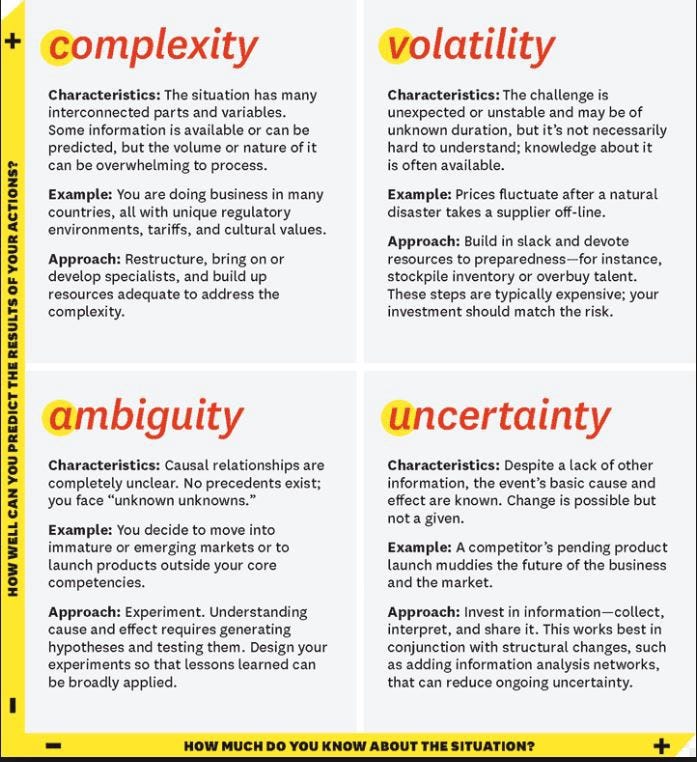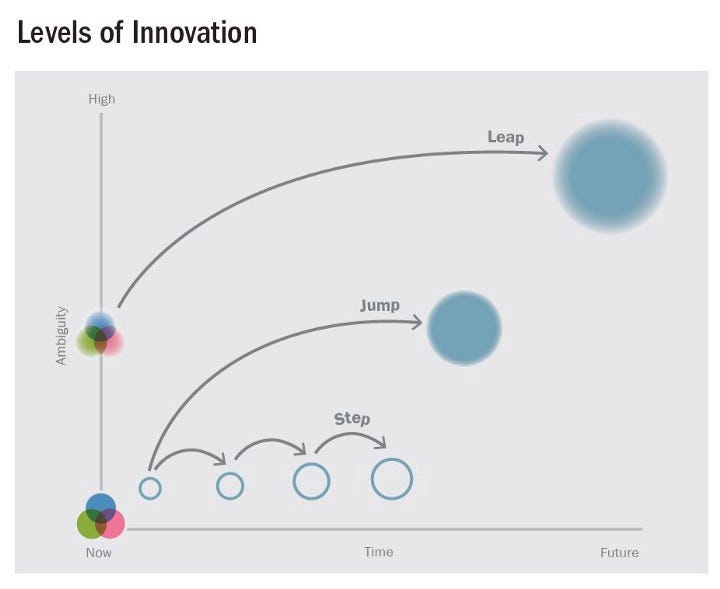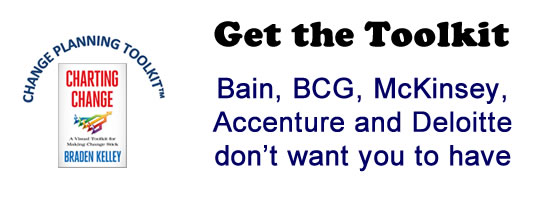How to Foster an Appetite for Risk by Using Ambiguity as a Resource

Some time ago I had a conversation with Jim Long, former Head of Creative Office and R&D and my mentor, about how innovation could succeed within a company. We agreed that for innovation to be truly transformative, it should be set at a distance where it cannot be interrupted by existing metrics and governance models. It should also be close enough to ease implementation and buy-in from the management. We concluded that company leaders should be happy with a 17–20% success rate with such innovation projects (borrowing from A.G.Lafely who expects that 80% of new product innovation will fail). Any more means you are not taking enough risks, any less means you are unable to reduce the complexity associated with innovation within the organization.
Protecting new (transformative) ideas from premature death and killing ideas that don’t balance the desirability, viability, and feasibility are both challenging ideas for large organizations. A big part of the innovation bottleneck in large organizations comes from the dominant discourse around defect-free operational excellence. Ambiguity is a weakness; it cannot be measured. Complexity is fine as long as it can be engaged efficiently. Certainty of success must be predetermined. These conversations often act against innovation.
In fact, these three things create such massive barriers that anyone even remotely interested in innovation within a large organization can lose interest. So what how can we overcome this sort of innovation lethargy?
A new role for designers
There are several examples of how organizations address these issues. Herman Miller overcomes this by making big bets on outside designers who are free to suggest new ideas to the company. HARMAN recently spun outHuemen, a design agency powered by more than 250 highly esteemed and experienced designers, to build ideas outside of their immediate corporate influence. Other large corporations are on the spree of acquiring design agencies to establish this capability within the walls of their companies requiring a new role for designers.
In this NYTimes article, Beckman points to Whirlpool which has traditionally been known for strong design, where designers used design-led innovation to develop the Duet line of washers and dryers, and then applied the business methods of Six Sigma to enhance them. Design thinking offers tools for exploring new markets and opportunities; Six Sigma skills can be used to improve existing products. Companies that adhere strictly to one or the other risk failure. In a recent conversation with Hari Nair, former chief designer at Whirlpool, he described a system of measurement his team developed to help decision making for new product development, incorporating marketing and technology viewpoints. This system is so popular within Whirlpool that it is constantly used around the world to evaluate new ideas. Tools such as this are critical to empowering design-led innovation within the management ecosystem.
Designers bring with them comfort for ambiguity, abilities to take higher risk, and the constant desire for experimentation. With new acquisitions and external engagement models, companies are asking designers to build bridges between design and existing efficiency models. They must not only be comfortable with new ideas, but they must also have the tools to leverage design thinking with efficiency models in the innovation pipeline.

Bennett, N., & Lemoine, J. (2014). What VUCA means for you?
Research by Coiculescu, Izhakian, and Ravid claims that innovation investments are significantly affected by both risk and ambiguity. Higher ambiguity leads firms and decision makers to overweight the likelihoods of adverse outcomes and underweights the possibilities of good outcomes. The intuition is that the higher the ambiguity, the lower is the perceived probability of a positive payoff.
However, ambiguity should not be seen as a weakness, it is a resource. And designers must be good at three things: managing ambiguity, reducing complexity, and eliminating uncertainty within the innovation process.
Here are a few ideas that have worked for me in the past…
1. Engage ambiguity as a resource and manage it
I appreciate what Patrice Martin (Creative Director and Co-Lead, IDEO.org) has to say about ambiguity, “by embracing ambiguity, and by trusting that the human-centered design process will guide us toward an innovative answer, we give ourselves permission to be fantastically creative.†However, not all ideas need to and can be explored in the same way. Nor do all ideas have the same level of unknowns. An important role innovation professionals play is to help the teams separate ideas that need more exploration from those that don’t.
You can balance ambiguity with risk by sorting innovation initiatives based on the proximity of currently available ideas and capabilities. I like the Levels of Innovation framework created by Patrick Whitney at the Institute of Design. It helps me assess existing and new projects by fitting them into one of three levels:

- Steps are incremental modifications to existing offerings whose practicalities remain within the known. Even though they may not be actively engaged, people within the company are familiar with these ideas;
- Jumps are similar to steps, but bring little more uncertainty as they involve new elements, for example, new technology or capability unfamiliar to the company;
- And Leaps are based on compelling new ideas, which open up whole new opportunity spaces. They also bring large levels of risk because there are no precedents at the company or outside and the level of ambiguity is really high.
I have found that such sorting is critical to making sure
- There is alignment across the team on where the ideas fall in the innovation spectrum.
- Ensure the right mix of ideas for a portfolio approach to innovation.
- Match the right capabilities and processes for each level of ideas.
2. Reduce complexity
Most innovation ideas fail to take off because teams do not adequately understand that ecosystem in which they play. Innovation professionals must not only be creative enough to come up with new ideas, but they must also map ecosystems to define relationships and value exchanges between stakeholders in the company.
Whenever I work with a new company, one of my first tasks is to engage stakeholder interviews as a way to learn, bring alignment and engagement of key business leaders into the project. Getting their view early on ensures that you have the right business lens for your outcome. I then print out large service blueprints, stakeholder maps, and pin them up over an entire wall of a room to display the diagram. This allowed everyone in my team to align on process and variables. It also enabled me to connect with business leaders to build empathy and get their input on my directions. The size and physicality of the display meant leaders would sometimes just stop by and engage in discussions with me, leading to conversations about how their teams can connect to the whole view that we had mapped out.
To reduce the apparent complexity of innovation, designers must learn to make the innovation pipeline tangible and visible to the stakeholders involved. They can do this by:
- Visualizing and displaying complex processes using frameworks like Service Blueprint, User Experience Journey maps, and others.
- Mapping current and future use cases using a series of narratives that build up a story with primary, secondary and supporting roles.
- Breaking the process down into tangible activities for each stakeholder.
- Tieing all outcomes directly to the business objectives early on and doing this multiple times during a project.
3. Eliminate uncertainty
Business leaders like certainty because their success is intrinsically linked to the success of their projects. They are incentivized for immediate returns. Designers, however, are trained to ignore certainty. Certainty means that you are unwilling to take big risks. This creates conflict.
For innovation to succeed, innovation leaders must be willing to eliminate the uncertainty. Eliminating uncertainty is not the same as defining certainty. It is a tactic to convince business leaders that you have accounted for all potential failure points. You are not committing that the water will flow in the end but that you have checked for holes in the pipe.
Designers can do this by:
- Reframing as a way of changing the conversation to ensure we are solving the right problem and asking the right questions of all stakeholders. When you engage leaders in the process of reframing, you get immediate buy-in from them.
- Asking the right set of questions using the right business vocabulary helps to build on each phase. The end of one phase should help to derive the next set of questions for business leaders. New unknowns or uncertainties should be seen as a way to engage the business leaders, not hide from them.
- Engaging creative storytelling to present ideas such that they are seen as good for investment, not ambiguous concoctions created in the mind of designers. Do this throughout the process, not just at the beginning and end. You don’t always need formal sit-down presentations…even a water cooler discussion can be used to eliminate uncertainty if you present a good story.
- Constant prototyping and testing within the context of the project help demonstrate the validity of the idea. Instead of focusing on validating an idea when it’s complete and ready, go out there to test and get feedback early on. The more you can show that end-users like what you are doing, the more you eliminate uncertainty in the minds of the business leader.
I started Khoj Lab an innovation consulting to bring my in-house experience marrying operational efficiency with the creative design process. Khoj Lab works closely with clients to help them transform by converting research learnings into actions and support their strategic initiatives. It’s amazing to take a step back and see those same challenges outside in and solve them closely with my clients. I am able to apply the above techniques to help them not only to create their new offerings but also make sure we tackle innovation bottlenecks on the way. Otherwise, we know our solution will never create value for their customers.
This article is part 5 of a 6 part series about innovation flow which began with my first insight “Innovation is not ideation.†In the next article, I will further discuss the seven wastes in the innovation process that I have seen through my experience.
Please follow my stories on Medium. If you have comments, please leave them below or email me directly at shilpi.kumar@khojlab.com
A special thanks to people who informed my content in this article: Anijo Mathew who helped with editing, my mentees, and my mentors (Herman Miller) Jim Long and John Cain who informed my thinking and inspired me to write this article.
Wait! Before you go…
Choose how you want the latest innovation content delivered to you:
- Daily — RSS Feed — Email — Twitter — Facebook — Linkedin Today
- Weekly — Email Newsletter — Free Magazine — Linkedin Group
 Shilpi Kumar an inquisitive researcher, designer, strategist and an educator with over 15 years of experience, who truly believes that we can design a better world by understanding human behavior. I work with organizations to identify strategic opportunities and offer user-centric solutions.
Shilpi Kumar an inquisitive researcher, designer, strategist and an educator with over 15 years of experience, who truly believes that we can design a better world by understanding human behavior. I work with organizations to identify strategic opportunities and offer user-centric solutions.
NEVER MISS ANOTHER NEWSLETTER!
LATEST BLOGS
How Brexit Has Affected UK E-commerce Businesses
Photo by Zyro on Unsplash The popularity of online shopping was already growing at an impressive rate – and…
Read MoreOvercoming range anxiety: three tips for EV owners
Photo by Jenny Ueberberg on Unsplash In the last few years, electric vehicles (EVs) have become more and more…
Read More


